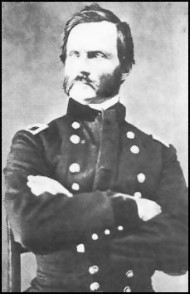James Henry Carleton

James Henry Carleton (December 27, 1814 – January 7, 1873) was an officer in the Union army during the American Civil War. Carleton is most famous as an Indian fighter in the southwestern United States.
Carleton was born in Lubec, Maine. He took part in the Aroostook War and Mexican-American War. He served in the 1st U.S. Dragoons in the American West.
In 1861 Carleton raised and was appointed colonel of the 1st California Volunteer Regiment. In 1862 he led the so-called California Column across California, Arizona, New Mexico, and into Texas. Along the way the Californians fought the Battle of Picacho Pass and, afterward, the Battle of Apache Pass. Carleton was breveted a brigadier general of volunteers on April 28, during the march from California to Arizona. He also established Fort Bowie near Apache Pass. Carleton finally linked up with Union forces under General Edward R. S. Canby in New Mexico. After the Confederate threat to New Mexico seemed to have been eliminated, Canby and many of the Union forces were sent to the east; so, in late August, Carleton was placed in command the Department of New Mexico. Because of uncertainty as to whether the Confederates would try to re-invade New Mexico, Carleton took measures such as maintaining spies along the New Mexico-Texas border and retaining the services of volunteer units from Colorado which had played a prominent role in expelling the Confederates from New Mexico in the winter and spring of 1862.
During his tenure as department commander, Carleton was mainly concerned with Indian threats. His primary field commander was Colonel Christopher "Kit" Carson. Carleton campaigned relentlessly against the Indians. He was a harsh commander but was well-respected by his men. Carleton's campaigning brought the "depradations" of the Navajo to an end at Canyon de Chelly. Carleton next sent Carson on an expedition to rid the southwest of Indian raids which resulted in the Battle of Adobe Walls. Carleton was appointed brevet major general in the regular army in 1865, the same year that the Civil War ended. He retained command of his volunteer troops until 1866 when U.S. Regulars took over in the West. Carleton served as a lieutenant colonel of the 4th U.S. Cavalry after the war.
Carleton wrote several books on the military: The Battle of Buena Vista (1848), Diary of an Excursion to the Ruins of Abo, Quarra, and the Grand Quivira in New Mexico in 1853 (1855), The Mountain Meadows Massacre (1859), and The Prairie Log Books (posthumous, 1944). It was partly on the strength of The Battle of Buena Vista that Carleton received an appointment from Secretary of War Jefferson Davis in 1856 to make a study of European cavalry tactics. Carleton did not make the trip abroad himself, but based his report on the observations of Gen. George B. McClellan who had recently returned from Europe. One of Carleton's children, Henry Guy Carleton (1852-1910) was a journalist, playwright, and inventor. General Carleton died in San Antonio, Texas, and is buried in Mount Auburn Cemetery, Cambridge, Massachusetts; his son, Henry was later buried beside him.
See also
References
- California State Military Museum biography
- Eicher, John H., & Eicher, David J., Civil War High Commands, Stanford University Press, 2001, ISBN 0-8047-3641-3.
- Hunt, Aurora, James H. Carleton, 1814-1873, Western Frontier Dragoon, Frontier Military Series II, Glendale, California: The Arthur H. Clark Company, 1958.
